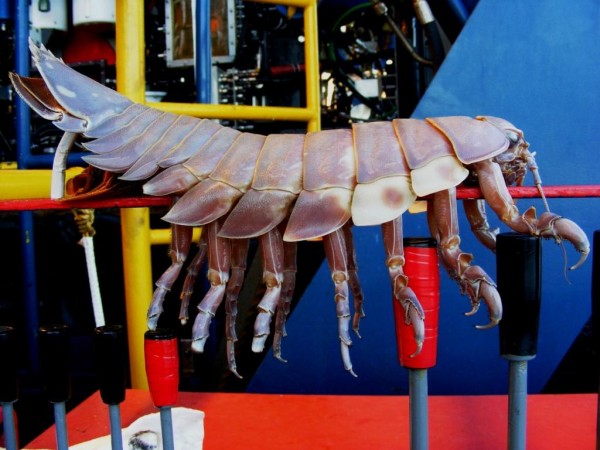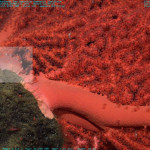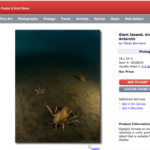 Across the internets a craze is sweeping. We here at DSN are calling it Isopocalypse 2010 (stay up to date using the Twitter hashtag #isopocalypse2010). Things got so crazy over the last two days with giant isopods that in my excitement I forgot what year it was and used #isopocalypse2011 hashtag this morning
Across the internets a craze is sweeping. We here at DSN are calling it Isopocalypse 2010 (stay up to date using the Twitter hashtag #isopocalypse2010). Things got so crazy over the last two days with giant isopods that in my excitement I forgot what year it was and used #isopocalypse2011 hashtag this morning
It all started on Reddit where the following comment was posted
I work for a Sub-sea Survey Company, recently this beast came up attached to one of our ROVs. It measures a wee bit over 2.5 feet head to tail, and we expect it latched onto the ROV at roughly 8,500 feet depth. Unfortunately, the e-mail that these pictures were attached to came from a contractor, and the ship he was operating from (and therefore location) is unknown, so I can’t tell you what part of the Earth this beast was living.
Word from an email I received is that the ROV was submerged on the West Sirius Oil Rig in the Gulf of Mexico. The picture that accompanied the post…

That’s when $%@# got crazy.
Fox News hit the scene with Terrifying Sea Critter Hauled from Ocean’s Depths in which several heinous errors were made. First the piece refers to it as a “crablike creature”. First isopods are in the Order Isopoda and crabs are in the Order Decapoda. Although both are crustaceans, this statement is the equivalent of saying an elephantlike bat. The Fox article proceeds to cite our old giant isopod post over at ScienceBlogs instead the posts on giant isopods here at the new improved DSN. The Fox story also cherry picks from original post stating that I posted that their large size is related to temperature. Reading the actual post you will see that I clearly state others proposed this and that I believe the size to be an adaptation to living in the food-limited deep sea (as I have proposed for other deep-sea invertebrates, press coverage here).
Alternatively, the larger size also increases fasting potential because greater fat reserves can be maintained. Larger size also confers a greater foraging area, important for either a scavenger or a predator. Both of these are important adaptations in the food-limited deep sea.
Unfortunately these errors were also perpetuated by National Geographic. Come on Fox News! Of course this is not nearly as annoying as legitimate news sources citing unsubstantiated wikipedia information as a reference.
Really wacky is the supposed diet of the Giant Isopod. “They feed on the carcasses of whales, giant squid, and other large sea creatures.” It is true that the Giant Isopod is an opportunistic scavenger and is known to feed on the carcasses of other organisms. But compare the previous information on the diet compared to that of Kevin on his thoroughly researched but apparently ignored post.
Gut content analysis of B. giganteus show mostly fish fragments, as well cephalopod, caridean shrimp and galatheid crab remains (3). In smaller quantities, sponge fragments, other isopods, echinoderms, nematodes and tunicates have been found (1, 3)…Most authors agree that B. giganteus is a scavenger (3, 5, 6), but some suggest it is also a facultative predator (3, 6). Specimens in aquaria have survived 8 weeks between feedings (5) and it speculated that this may be an adaptation for carrying its brood, which would be severely impacted by a full stomach (3)…B. giganteus has also been collected from baited traps outside of methane seeps in the northern Gulf of Mexico (11).
Giant squid? Where did that come from?
Of course I also have a problem with people referring to this beloved creature as a terrifying sea beast, terrifying sea creature, a sea roach or cockaroach (a comparison even worse comparing it to a crab), and monster or prehistoric creature that led on person to say ““KILL IT! KILL IT WITH FIRE! OH GOD OH GOD GET IT AWAY!” Giant Isopods are magnificent creatures nothing short of an spectacular evolutionary trajectory.
Another error is “Fossil records date these cockroaches of the sea back more than 160 million years, before the Earth’s continents were even formed.” Where did that information come from? The idea of a old and ancient deep-sea organisms has long ago been dispelled. The lack of deep-sea fossils, especially of large organisms, past 100 mya also flags this statement. Indeed, I think we can reasonably say we know little of when Giant Isopods emerged in time.
Another red flag is the unconfirmed report that this specimen is “more than 2 and half feet long“. As a reader reminded me (hat tip to D.K.), published work puts the length of Bathynomus giganteus “between the range of 27-37 cm. (~0.9-1.2ft). However, Soto & Mincarone (2001; Mare Magnum 1(2): 141-145) list 42 cm (~1.4ft) as the largest of 144 specimens they examined, and MacAvoy et al. (2002) indicate that they have a 48cm (~1.6ft) specimen in a collection somewhere.” So either this specimen is the mother of all Giant Isopods or this is just a great fish story.
Of course the other interesting thing to emerge from these stories is all the interesting titles bestowed to me. My favorite: “deep-sea biological systems expert”. Of course I prefer high commander of deep-sea science. Discovery News labels me as a postdoctoral fellow with MBARI, a position I haven’t held for well over a year. Wait a minute didn’t we use to work for them? Shouldn’t they know?
Of course, Kevin on Twitter wonders “Wait, can I be quoted without ever having been interviewed??” Which brings me to the next point…
Thankfully Alan Boyle comes to the rescue. He actually interviewed me. Yesterday Alan and I had a great discussion about Isopocalypse 2010. But Alan should also be commended because he did research. Other reporters take note, it is called research and you should do it. It is hard for scientists to not feel frustrated by the lack of accuracy on major points of the story. Overall, it leaves me wondering how issues like this help deteriorate any bridge between scientists and the media and degrading our trust in you.
Hat tip also goes to Alan for linking to www.deepseanews.com.
You can check out all our greatest giant isopod posts by following our giant isopod category.
[UPDATE #1] Isopocalypse 2010 may have claimed its first victim…me. The Sun states “Prof Craig McClain, of North Carolina’s National Evolutionary Synthesis Centre, said: “Some are even bigger. No one from The Sun ever spoke with me. As such, I am little unclear of how they could obtained a direct quote from me. Moreover, given my comments above you can clearly see that I believe quite the opposite.
[UPDATE #2-KZ] AOL News attributes a quote to me “Notes Deep Sea News blogger Kevin Zelnio, “the maximum reported size of Bathynomus giganteus is likely to be an artifact of our sampling.” though never talked to me. If they are quoting from one of our many giant isopod related posts I do not know since they did not link to any particular post where I might have said. In fact, I had to track it down and it was in a comment on Dr. M’s post about isopod body size evolution. le sigh…
[UPDATE #3] The woo continues at Mail Online. No sources are cited for the information and most of the statements are factually incorrect. “Many deep-sea crustaceans and invertebrates tend to be larger than their shallow-water counterparts. It is not yet known whether this is due to the colder temperature, higher pressure or scarcer food resources.” Actually, many deep-sea invertebrates tend to be smaller their shallow water counterparts. Thiel was the first to document this overwhelming trend in 1975. As to the second part, again although temperature is posited as the reason for deep-sea gigantism there is little to no support for this conjecture. Deep-sea miniaturization is the norm and exactly opposite of what you would expected if colder temperatures where driving size. In addition and as mentioned above, changes in body size are still observed in organisms in the deep sea even when temperature does not vary. No body has ever posited pressure to control body size and I cannot even think about how this mechanism would work.
[UPDATE #4] Perhaps its been unfair for me to criticize others without both expressing my own qualifications to speak on these issues and citing my references so
- McClain, C.R. and Rex, M.A. (2001) The Relationship Between Dissolved Oxygen Concentration and Maximum Size in Deep-Sea Turrid Gastropods: An Application of Quantile Regression. Marine Biology, 139: 681-685
- McClain, C.R., M. Fougerolle, M.A. Rex, and J. Welch. (2001) MOCNESS Estimates of the Size and Abundance of a Pelagic Gonostomatid Fish (Cyclothone pallida) off the Bahamas. Journal of the Marine Biological Association of the United Kingdom, 81:869-871
- McClain, C.R., M.A. Rex, and R. Jabbour. (2005) Deconstructing bathymetric patterns of body size in deep-sea gastropods. Marine Ecology Progress Series, 297:181-187
- McClain, C.R. (2005) Bathymetric patterns of morphological disparity in deep-sea gastropods from the western North Atlantic Basin. Evolution, 59:1492-1499
- McClain, C.R., A. Boyer, G. Rosenberg (2006) The island rule and the evolution of body size in the deep sea. Journal of Biogeography, 33:1578-1584 [featured article]
- McClain, C.R. and J. Crouse (2006) The influence of ecological role on bathymetric patterns of deep-sea species: size clines in parasitic gastropods. Marine Ecology Progress Series, 320:161-167
- Rex, M.A., R.J. Etter, J.S. Morris, J. Crouse, C.R. McClain, N.A. Johnson, C.T. Stuart, R. Thies, R. Avery (2006) Global bathymetric patterns of standing stock and body size in the deep-sea benthos. Marine Ecology Progress Series, 317:1-8 [featured article]
- McClain, C.R. and J.C. Nekola (2008) The role of local-scale process on terrestrial and deep-sea gastropod body size distributions across multiple scales. Evolutionary Ecology Research, 10:129-146
- Payne, J.L., A.G. Boyer, J.H. Brown, S. Finnegan, M. Kowalewski, R.A. Krause Jr., S.K. Lyons, C.R. McClain, D.W. McShea, P.M. Novack-Gottshall, F.A. Smith, J.A. Stempien, and S.C. Wang (2009) Evolution of maximum size on Earth. Proceedings of the National Academy of Science, U.S.A., 1:24-27
- McClain, C.R., M.A. Rex, and R.J. Etter. (2009) Macroecological Patterns in the Deep Sea. In Marine Marcoecology. Eds. K. Roy and J. Whitman. University of Chicago Press
- McClain, C.R. and A.G. Boyer (2009) Biodiversity and body size are linked across metazoans. Proceedings of Royal Society B: Biological Sciences, 276: 2209-2215 [Highlighted by Faculty of 1000]
- McClain, C.R. (2008) Giants and dwarfs in the deep sea. Cosmos, 21
Also see
- Thiel H (1975) The size structure of the deep-sea benthos. Internationale Revue des Gesamten Hyrdobiologie 60:575-606
- Thiel H (1979) Structural aspects of the deep-sea benthos. Ambio Special Report 6:25-31
- Rex MA, Etter RJ (1998) Bathymetric patterns of body size: implications for deep-sea biodiversity. Deep-Sea Research II 45:103-127
- Rex MA, Etter RJ, Clain AJ, Hill MS (1999) Bathymetric patterns of body size in deep-sea gastropods. Evolution 53:1298-1301
- Gage JD, Tyler PA (1982) Depth-related gradients in size structure and the bathymetric zonation of deep-sea brittle stars. Marine Biology 71:299-308
- Gage JD, Tyler PA (1991) Deep-Sea Biology: A Natural History of Organisms at the Deep-Sea Floor, Vol. Cambridge University Press, Cambridge
- Polloni P, Haedrich R, Rowe GT, Clifford CH (1979) The size-depth relationship in deep ocean animals. Internationale Revue des Gesamten Hyrdobiologie 64:39-64
- Monnoit C, Monniot F (1978) Recent work on the deep-sea tunicates. Oceanography and Marine Biology Annual Review 16:181-228
- Fujita T, Ohta S (1990) Size structure of dense populations of the brittle star Ophiura sarsii (Ophiuroidea: Echinodermata) in the bathyal zone around Japan. Marine Ecological Progress Series 64:113-122
- Olabarria C, Thurston MH (2003) Latitudinal and bathymetric trends in body size of the deep-sea gastropod Troshelia berniciensis (King). Marine Biology 143:723-730
- Sibuet M, Lambert CE, Chesselet R, Laubier L (1989) Density of the major size groups of benthic fauna and tropic input in deep-basins of the Atlantic Ocean. Journal of Marine Research 47:851-867
- Stoetaert K, Heip C (2002) Size and shape of ocean margin nematodes: morphological diversity and depth-related patterns. Marine Ecology Progress Series 242:179-193
Of course you will also want to see
- Barradas-Ortiz, C., P. Briones-Fourzan, and E. Lozano-Alvarez. 2003. Seasonal reproduction and feeding ecology of giant isopods Bathynomus giganteus from the continental slope of the Yucatan peninsula. Deep Sea Research Part I: Oceanographic Research Papers 50:495-513.
- Biesiot, P. M., S. Y. Wang, H. M. Perry, and C. Trigg. 1999. Organic reserves in the midgut gland and fat body of the giant deep-sea isopod Bathynomus giganteus. Journal of Crustacean Biology 19:450-458.
- Briones-Fourzán, P., and E. Lozano-Alvarez. 1991. Aspects of the biology of the giant isopod Bathynomus giganteus A. Milne Edwards, 1879 )Flabellifera: Cirolanidae), off the Yucatan Peninsula. Journal of Crustacean Biology 11:375-385.
- Chamberlain, S. C., V. B. Meyer-Rochow, and W. P. Dossert. 1986. Morphology of the compound eye of the giant deep-sea isopod <I>Bathynomus giganteus</I>. Journal of Morphology 189:145-156.
- Cocke, B. T. 1986. Deep-sea isopods in aquaria. Tropical Fish Hobbyist 35:48-52.
- Holthuis, L. B., and W. R. Mikulka. 1972. Notes on the deep-sea isopods of the genus Bathynomus A. Milne Edwards, 1879. Bulletin of Marine Science 22:575-591.
- Klages, M., S. Muyakshin, T. Soltwedel, and W. E. Arntz. 2002. Mechanoreception, a possible mechanism for food fall detection in deep-sea scavengers. Deep Sea Research Part I: Oceanographic Research Papers 49:143-155.
- Kussakin, O. G. 1973. Peculiarities of the geographical and vertical distribution of marine isopods and the problem of deep-sea fauna origin. Marine Biology 23:19-23.
- Lemos de Castro, A. 1978. Descricao de uma especie nova gigante do genero Bathynomus Milne-Edwards do litoral brasileiro (Isopoda, Cirolanidae). Revista Brasileira de Biologia 38:37-44.
- Lloyd, R. E. 1908. The internal anatomy of bathynomus giganteus, with a description of the sexually mature forms. Memoirs of the Indian Museum 1:81-102.
- MacAvoy, S. E., R. S. Carney, C. R. Fisher, and S. A. Macko. 2002. Use of chemosynthetic biomass by large, mobile, benthic predators in the Gulf of Mexico. Marine Ecology Progress Series 225:65-78.
- Milne-Edwards, A. 1879. On a gigantic isopod from the great depths of the sea. Annals and Magazine of Natural History 5:241-243.
- Pless, D. D., M. B. Aguilar, A. Falcon, E. Lozano-Alvarez, and E. P. Heimer de la Cotera. 2003. Latent phenoloxidase activity and N-terminal amino acid sequence of hemocyanin from Bathynomus giganteus, a primitive crustacean. Archives of Biochemistry and Biophysics 409:402-410.
- Steeves, H. R. I. 1969. Lipid contents of the hepatopancreas of the isopod Bathynomus giganteus A. Milne Edwards, 1879. Crustaceana 16:135-138.






Bah you ain’t seen nothing until you seen one chew off thumbnail sized chunks of a pigs head from a submarine at 1800′ makes them crunchy sounds too!
How big is the individual in the image?
Dusty,
That is the specimen that is claimed to be near 2.5ft
Phenomenal post Dr. M.
I look forward to the next news article that misquotes you:
“Isopods are coming for all your babies and they will eat your brains,” said the High Commander of Deep Sea Science
But do they taste like crab?
Just because you’ve published a dozen scholarly articles on the subject doesn’t make you an expert on isopodophobia (I’m sure the new DSM will recognize it and recommend buckets of psychotropic medication). The only logical reason why we haven’t received verification of it’s enormous size must be because it devoured the crew after being photographed and tweeted without its permission. I’m building a bunker.
Correction: there are NO legitimate “news” sources, everyone is biased in their own special way.
Its pretty funny though how you can be quoted without delivering a quote. Im not sure how that works but at least you dont have to work to get publicity. I just decided that you told me “they can survive a nuclear war, cure cancer, amputate a limb by thought, find the g spot and they gave Alec Baldwin herpes in 1992”
“they can survive a nuclear war, cure cancer, amputate a limb by thought, find the g spot and they gave Alec Baldwin herpes in 1992″
Now that is something I would actually say ;-)
That was the best rant I have ever read. Informative, well written, fact filled with quotes and footnotes! Great read!
I just want to point out that for all the outrage you muster, you cite the same source over and over, and then garbage. To whit, National Geographic is mostly owned by Fox, and in fact the link you point to is the exact Fox article. Then you site aggregators (popfi and nextreporter) and you’re bothered by a jokey post in nymag that is explicitly tongue in cheek.
There’s plenty of bad science reporting to be critiqued out there, but mostly the problem seems to be with a single crappy story in Fox News. Let me tell you how shocked I am that Fox News produces crappy stories.
Not. At. All.
But maybe try ranting with a finer brush next time.
— “Fox News hit the scene with Terrifying Sea Critter Hauled from Ocean’s Depths in which several heinous errors were made. … Unfortunately these errors were also perpetuated by National Geographic.”
FOX is a 54% owner of the National Geographic Channel. No surprise that FOX content runs under the NatGeo banner with a FOX byline and a credit to the same FOX writer.
— “legitimate news sources”
“The Next Reporter”? It’s just another crap aggregation blog. That’s like calling my public GReader page a legitimate news source.
— Another error is “Fossil records date these cockroaches of the sea back more than 160 million years, before the Earth’s continents were even formed.” Where did that information come from?
The “fossil records” link in the AOLNews article links to Google Books’ preview of Andrew Parker’s “In the Blink of an Eye: How Vision Kick-started the Big Bang of Evolution,” which is cited in the Wikipedia article for giant isopods.
— “Another red flag is the unconfirmed report that this specimen is ”more than 2 and half feet long“.”
OK, yeah, that came from the Reddit post that supposedly started this whole snowball.
— As a reader reminded me (hat tip to D.K.), published work puts the length of Bathynomus giganteus “between the range of 27-37 cm. (~0.9-1.2ft). However, Soto & Mincarone (2001; Mare Magnum 1(2): 141-145) list 42 cm (~1.4ft) as the largest of 144 specimens they examined, and MacAvoy et al. (2002) indicate that they have a 48cm (~1.6ft) specimen in a collection somewhere.” So either this specimen is the mother of all Giant Isopods or this is just a great fish story.
So Dr. M says a 30″ giant isopod is a sign that at least the measurement is bunk. Right? Biggest published is 14″, maybe 18″.
— “Thankfully Alan Boyle comes to the rescue. He actually interviewed me. Yesterday Alan and I had a great discussion about Isopocalypse 2010. But Alan should also be commended because he did research. Other reporters take note, it is called research and you should do it.”
In Alan’s article:
— an expert on deep-sea species says the bizarre giant bug shown in pictures circulating on the Internet is the real deal.
— “I’ve seen the pictures, and they are real, and they really do get that big,” Craig McClain, assistant director of science for the National Evolutionary Synthesis Center in North Carolina, told me today.
— But this deep-sea isopod is no pea-sized rolypoly: The critter grows to a size of 20 inches or more. The bug shown in the pictures that are currently making the rounds is on the “larger size” of the spectrum, measuring 30 inches in length, McClain said. But there are a lot more big bugs out there.
In the story where you’re quoted by the reporter whom you single out for doing a good job, you say the photos and claimed length are legit – claims backed by a reporter for a more respected news source (MSNBC) than any of the ones with which you find fault – and directly contradict your assertion in this post that a 1’6″ specimen is exceptionally large and 2’6″ would be “the mother of all Giant Isopods.”
I’m not trying to side with science reporters. I agree that they do a poor job more often than not. I work with reporters often tasked with science stories.
But what’s the deal? As a journalist, do I believe the Craig McClain who says a 2’6″ specimen isn’t possible, or the Craig McClain who says “they really do get that big”?
More O2 bigger size. And the primary point to consider is that more O2 would also at some point create a more heavily oxygenated deep ocean than the surface which only goes to 1/2 mile before the no ox zone. And then……….the ocean turn over. Simple. Been done before, we survived then but now the oil is everywhere, more toxins to deliver to the deep. Who knows?
Awww, I think he’s cute… Like a giant pill bug. I wish they didn’t live too deep… I’d want one as a pet. If someone was able to replicate the depths within an enclosed space, I bet they’d be fascinating to watch!
If the picture is altered, creature appears to be like 51 inches if you figure the typical iron rebar used for marine ship ladders is like 2.5 inches … that would be a 51 inch creature… he looks that big to me ! lol
If the photo is NOT altered : correction
… In fact…with a 2.5 measurement on the yellow vertical rail of the ladder , the creature DOES measure a wee bit over 51 inches…. all righty then… prrrretty big isopod prrretty much… ya.
—————-So is it: PHOTOSHOPPED —or NOT ???————-